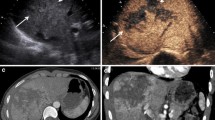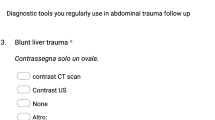Abstract
Purpose
The purpose of this study was to retrospectively investigate the application of emergency contrast-enhanced ultrasonography (CEUS) in blunt pancreatic trauma.
Materials and methods
Twenty-two consecutive patients with blunt pancreatic trauma were examined using CEUS from March 2007 to June 2012. The findings of CEUS were compared with those of contrast-enhanced computed tomography scans at level-1 diagnostic tests.
Results
Out of the 22 patients, 21 were diagnosed with blunt pancreatic injury using CEUS, including 8 patients with lesions in the neck of pancreas, 9 in the body, 3 in the tail and 1 in the head. The injury sites appeared as anechoic and/or hypoechoic perfusion defect regions with irregular borders in parenchyma and capsule on CEUS images. The lesion sizes measured by CEUS were 1.88 ± 0.81 cm, which were consistent with the 1.93 ± 0.77 cm measured by CT (p > 0.05). Using CT as a reference standard, the detection rate of CEUS in blunt pancreatic trauma was 95.5 % (21/22).
Conclusions
CEUS findings can be used to provide a reliable diagnosis for blunt pancreatic trauma. CEUS is thus promising in the assessment of blunt pancreatic trauma, especially in institutions where emergency CEUS is used as an initial diagnostic instrument.




Similar content being viewed by others
References
Al Ahmadi K, Ahmed N (2008) Outcomes after pancreatic trauma: experience at a single institution. Can J Surg 51:118–124
Jurkovich G, Bulger EM (2004) Duodenum and pancreas. In: Mattox KL, Moore ME, Feleciano DV (eds) Trauma. McGraw-Hill Companies, New York, pp 709–734
Cogbill TH, Moore EE, Kashuk JL (1982) Changing trends in the management of pancreatic trauma. Arch Surg 117:722–728
Henarejos A, Cohen DM, Moossa AR (1983) Management of pancreatic trauma. Ann R Coll Surg Engl 65:297–300
Olsen WR (1973) The serum amylase in blunt abdominal trauma. J Trauma 13:200–204
Bouwman DL, Weaver DW, Walt AJ (1984) Serum amylase and its isoenzymes: a clarification of their implications in trauma. J Trauma 24:573–578
Bradley EL 3rd, Young PR Jr, Chang MC (1998) Diagnosis and initial management of blunt pancreatic trauma: guidelines from a multiinstitutional review. Ann Surg 227:861–869
Fleming WR, Collier N, Banting S (1999) Pancreatic trauma: universities of Melbourne HPB group. Aust N Z J Surg 69:357–362
Beckingham IJ, Krige JE (2001) ABC of diseases of liver, pancreas, and biliary system: liver and pancreatic trauma. BMJ 322:783–785
Scollay JM, Yip VS, Garden OJ, Parks RW (2006) A population-based study of pancreatic trauma in Scotland. World J Surg 30:2136–2141
Gorg C, Bert T (2005) Contrast enhanced sonogra-phy of focal splenic lesions with a second-generation contrast agent. Ultraschall Med 26:470–477
Tang J, Li W, Lv F et al (2009) Comparison of gray scale contrast-enhanced ultrasonography with contrast-enhanced CT in different grading blunt hepatic and splenic trauma: an animal experiment. Ultrasound Med Biol 35:566–575
CatalanoO Lobianco R, Sandomenico F, Siani A (2003) Splenic trauma: evaluation with contrast-specific sonography and a second-generation contrast medium: preliminary experience. J Ultrasound Med 22:467–477
Catalano O, Lobianco R, Sandomenico F et al (2004) Real-time, contrast-enhanced sonographic imaging in emergency radiology. Radiol Med 108:454–469
Catalano O, Lobianco R, Raso MM, Siani A (2005) Blunt hepatic trauma: evaluation with contrast-enhanced sonography: sonographic findings and clinical application. J Ultrasound Med 24:299–310
Cokkinos DD, Antypa E, Kalogeropoulos I et al (2013) Contrast-enhanced ultrasound performed under urgent conditions. Indications, review of the technique, clinical examples and limitations. Insights Imaging 4:185–198
Morel DR, Schwieger I, Hohn L et al (2000) Human pharmacokinetics and safety evaluation of SonoVue, a new contrast agent for ultrasound imaging. Invest Radiol 35:80–85
Wong YC, Wang LJ, Lin BC et al (1997) CT grading of blunt pancreatic injuries: prediction of ductal disruption and surgical correlation. J Comput Assist Tomogr 21:246–250
Miele V, Buffa V, Stasolla A et al (2004) Contrast enhanced ultrasound with second generation contrast agent in traumatic liver lesions. Radiol Med 108:82–91
Valentino M, Serra C, Zironi G et al (2006) Blunt abdominal trauma: emergency contrast-enhanced sonography for detection of solid organ injuries. Am J Roentgenol 186:1361–1367
Valentino M, Ansaloni L, Catena F et al (2009) Contrast-enhanced ultrasonography in blunt abdominal trauma: considerations after 5 years of experience. Radiol Med 114:1080–1093
Valentino M, Galloni SS, Rimondi MR et al (2006) Contrast-enhanced ultrasound in non-operative management of pancreatic injury in childhood. Pediatr Radiol 36:558–560
Song Q, Tang J, Lv FQ et al (2013) Evaluation of blunt pancreatic injury with contrast-enhanced ultrasonography in comparison with contrast-enhanced computed tomography. Exp Ther Med 5:1461–1465
Cirillo RL Jr, Koniaris LG (2002) Detecting blunt pancreatic injuries. J Gastrointest Surg 6:587–598
Hall RI, Lavelle MI, Venables CW (1986) Use of ERCP to identify the site of traumatic injuries of the main pancreatic duct in children. Br J Surg 73:411–412
Acknowledgments
We would like to express our gratitude to the Natural Science Foundation of China (Grant No. 81071279) and the Public Welfare Scientific Research Project of the Chinese Ministry of Health (Grant No. 201302017) for their financial supports for this project.
Conflict of interest
Faqin Lv, Jie Tang, Yukun Luo, Yongkang Nie, Tong Liang, Ziyu Jiao, Zhihong Zhu, Tanshi Li declare no conflict of interest.
Author information
Authors and Affiliations
Corresponding author
Rights and permissions
About this article
Cite this article
Lv, F., Tang, J., Luo, Y. et al. Emergency contrast-enhanced ultrasonography for pancreatic injuries in blunt abdominal trauma. Radiol med 119, 920–927 (2014). https://doi.org/10.1007/s11547-014-0410-3
Received:
Accepted:
Published:
Issue Date:
DOI: https://doi.org/10.1007/s11547-014-0410-3




